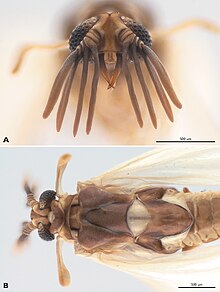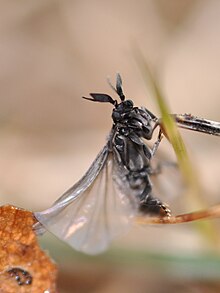Fan wing
| Fan wing | ||||||||||||
|---|---|---|---|---|---|---|---|---|---|---|---|---|

Three females of Stylops melittae on a willow sand bee ( Andrena vaga ) |
||||||||||||
| Systematics | ||||||||||||
|
||||||||||||
| Scientific name | ||||||||||||
| Strepsiptera | ||||||||||||
| Kirby , 1813 | ||||||||||||
| Submissions | ||||||||||||
The fan-winged (Strepsiptera) are an insect order within the new winged (Neoptera), which undergo at least part of their development as internal parasites of other insects. About 60 of the known 550 species live in Europe . The body length of the males is between 1.5 and 7.5 mm, that of the females between 1.5 and 30 mm.
Construction of the fan wing

The fan-winged birds show a pronounced sexual dimorphism .
The males, in contrast to the always wingless females, are always winged. However, the front wings have been converted into holders . The large hind wings are folded like a fan before hatching (hence the German name "fan wing ") and have only very rudimentary wing veins . The rearmost breast segment, where the wings attach, is very large. The males also have very large compound eyes with (compared to the females) many individual eyes and antennae with lateral appendages. Their lifespan as adult animals is only a few hours. This time is just enough to find and mate the females with the help of the fragrances they emit ( insect pheromones ). This usually takes place at dawn.
The females of the basal Strepsiptera are free-living after they leave the host at the end of their second larval stage. They are similar to the males, only more simply built. The complex eyes (compound eyes) consist of a few individual eyes, the antennae are shorter and have no extensions. Some animals remain in their solid shell, the puparium , which is made up of the skins ( exuvia ) of the last larval or pupal stage, and can therefore not be mated by males. Such females reproduce independently ( parthenogenesis ). The females of the derived Strepsiptera (Stylopidia) have adapted completely to the way of life as an internal parasite. The sexually mature female bores only with the front end of the body from the abdomen of the host . At most they have simple mouthparts. The head and front body are fused to form a head chest ( cephalothorax ), the legs are reduced. The abdomen becomes sac-like as the larvae develop, making them look like maggots. The internal organs are broken down until only the sex organs are left.
Reproduction and development
In the case of the fan-winged birds, mate is found by means of pheromones , which the male follows to the female who is giving up. There it injects the sperm into the abdomen of the female, which has no special sex opening. The females then "produce" around a few hundred to thousands of tiny larvae ( triungulinoids ), which can move freely and are equipped with legs, eyes and jumping bristles. This first larval stage looks for other insect species as hosts and penetrates them. Often the host's larva is already attacked. The first larva of the fan wing is also known as the stage of infection. In the host it sheds its skin to the second larval stage, the feeding stage. During this time it lives on the body fluids ( hemolymph ) of the host and sheds its skin several times to higher larval stages. Then the female second larva leaves the host and pupates (basal fan-winged) or breaks through the outer shell of the host between the segments, so that the head and breast protrude and pupate (derived fan-winged stylopidia). The skinned shell is not put down, but the animal remains in it and continues to shed its skin. The resulting shell is called the puparium . The males remain in the host, bore their front end out of the host's abdomen and pupate. The sexually mature males then slip out of their puparium by blowing off the lid and start looking for females ready to mate. The hosts populated by fan- winged birds are called stylopized .
Systematics of the fan wing
The fan-winged birds are divided in a classical way into two sub-orders: the basal Mengenillidae with free-living females and the derived Stylopidia with the lifelong parasitic females. According to research in 2009, the great-winged fan is considered to be a sister group of the beetles .
Fossil evidence
Fossil fan-winged birds are rare. The oldest evidence was found in approx. 100 million year old Cretaceous amber from southwest France ( Département Charente-Maritime ) and amber from Myanmar of about the same age . The only known fossil larva of this insect order comes from Eocene coal from the Geiseltal (near Halle). The primary larva belongs to the phylogenetically young family Myrmecolacidae. In addition, fan-winged birds are known from various tertiary amber deposits. From Baltic amber alone , eleven species have been described, which are distributed across five families.
Web links
Individual evidence
- ↑ Compared to other insects, the males also have relatively few individual eyes. See for example New Insect: A Unique View of the World (Spiegel Online via Xenos peckii November 5, 1999)
- ↑ Wiegmann et al. 2009 BMC Evolutionary Biology 7, 34
- ^ David Penney & James A. Jepson: Fossil Insects. Manchester (UK) 2014.
- ^ Hans Pohl: The oldest fossil strepsipteran larva (Insecta: Strepsiptera) from the Geisel Valley, Germany (Eocene). In: Insect Systematics & Evolution 40 (4), Houston 2009, pp. 333-347.
- ↑ Carsten Gröhn: inclusions in Baltic amber. Hamburg 2015.
